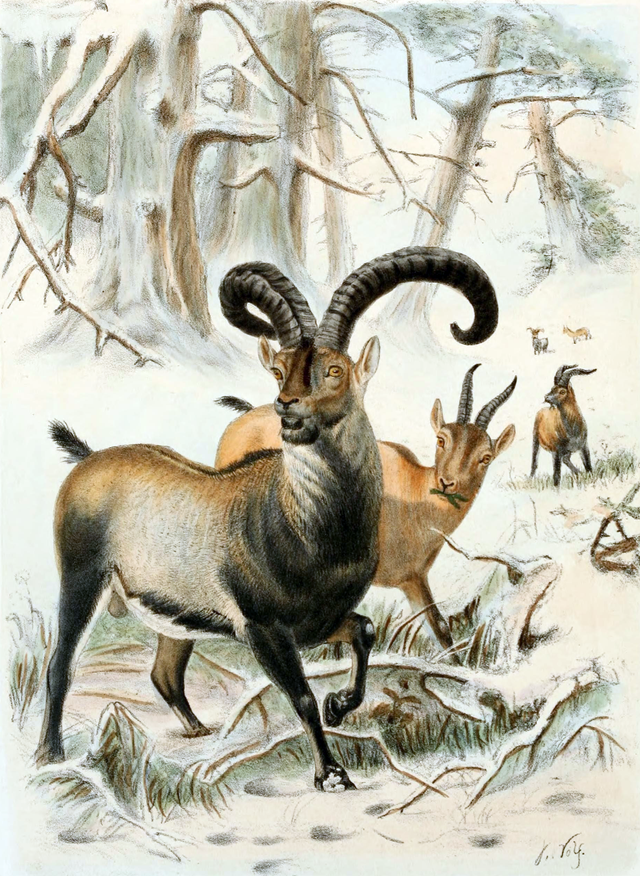The Pyrenean ibex is the first species to be brought back from extinction by scientists (but only for a short while)
The Pyrenean ibex (Capra pyrenaica pyrenaica) is one of the four subspecies of the Spansh ibex (Capra pyrenaica), that sadly became extinct in January 2000. Before this, it was found in mountain areas in Portugal, Spain, Andorra and France, until humans successfully hunted such a large part of the population that it became extinct.

A sketch of the Pyrenean ibex. Image by Joseph Wolf, posted under {{PD-US}} – Public Domain.
Due to the nature of the recent extinction, scientists has lots of good genetic material to work with, and this eventually lead to experiments where they attempted to bring the species back from extinction.
The de-extinction method
The de-extinction started by using tissue samples from the last living Pyrenean ibex. The samples were taken in 1999, just one year before the last living animal died. To bring the species back from extinction, the scientists that worked on the project inserted the nuclei from the cells into the egg cells of 208 female goats (Capra hircus). This would impregnate them, acting as surrogates to the Pyrenean ibex.
The DNA inserted into the goats was the same as the DNA from the tissue sample, so the individuals that would be given birth to by the goats were clones of the last living Pyrenean ibex. This also lead to another problem, where the placenta of mammals does not like having foreign offspring inside them, so before being ready to give birth, 207 of the goats gave stillbirth.
The Pyrenean ibex reborn
If you did some quick math while reading this, you would already know that one of the goats actually gave birth to a Pyrenean ibex! This is the very first time an extinct species has ever been brought back to life, and marked a big milestone in de-extinction efforts.
Despite having brought the Pyrenean ibex back from extinction, the species would not survive for long. After only a few minutes (some sources claim 7 minutes, some claim 3 minutes, and other even claim 10 minutes), the Pyrenean ibex died due to a physical defect in her lungs. This was not especially surprising given the fact that lung problems had been very problematic when cloning sheep in the past.
This means that the Pyrenean ibex became extinct for the 2nd time, just a few minutes after officially becoming de-extinct.
The last Pyrenean ibex, Celia, which was the individual that was used for the cloning process. Image by Jose Miguel Pintor Ortego, posted with the Creative Commons Attribution-Share Alike 4.0 International license.
What would happen if it were to survive?
Even if the cloned Pyrenean ibex had survived for more than a few minutes, there would still be many problems before it could be introduced back into the wild. Firstly, since the DNA was taken from a grown animal, the shortened telomeres would reduce its expected lifespan.
The scientists also only had samples from a female, so it would not be possible to clone a male, which would be needed if the species were to be reintroduced into the wild.
This de-extinction was more of an experiment than a real attempt to reintroduce the Pyrenean ibex, but it is still considered a great achievement in de-extinction methods.
Is it possible to bring extinct species back to life?
There are many scientists that are working on bringing extinct species back to life, and this experiment showed that it is possible, but it is still unlikely that we will be able to reintroduce an extinct species back into the wild in the near future.
My personal opinion on the subject is that we should rater focus our resources to save the species that are endangered, because they are dying in a record pace right now, and there are many vulnerable species that could benefit a great deal from more conservation efforts. However, I think experiments like these are very interesting, and hopefully it will eventually get to the point where we are able to restore some of the extinct keystone species back into the wild.
Thank you for reading
Thanks for reading this post! Please let me know what you think about de-extinction in the comment field, and make sure to follow me for more nature and biology related posts!
))
I agree we should avoid letting species go extinct. But I find this news fascinating! Upvoted and resteemed.
Thank you! I'm happy to hear that you enjoyed my post :)